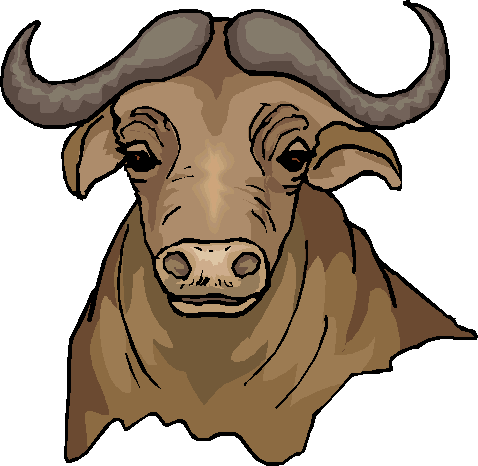The dusk has taken the heat and hectic away from the Barangay. The sharp contours of the day are beginning slowly to blur into a green blackness ...... and there they are again: The grey black water buffalos, grazing peacefully on the swampy banks of a river. One animal with a small boy standing on its back is slowly with swaying stapes rejoining the herd. It leisurely drops its front paws and puts down the back. Birds that have now flown to the animals start searching for insects on the animal bodies. Some buffalos are wallowing in the mud, of others, you can only see their noses above the waterline ("carabao fishes").
Waterbuffolos were domesticated 5000 years ago, their number is estimated at 148 million world-wide. Animals who still live in a truly wild state like the small shouldered Tamaro from Mindoro are extremely rare. The main area in which they are wide- spread is South East Asia, although there are also 83.000 to be found in Italy. An adult water buffalo has a body length between two and a half and three meters. It's shoulder height can be between 150-180 cm. The bulls weight can range between 500 and 900 kg , the cow's from between 350 and 650 kg. The body possesses a bulky, deeply set rump, which is supported by relatively short legs. The head is rather long and thin. When the backward growing sickle like horns are cross- sectioned they are triangular and flat, they can reach a length of 120 cm and they do not shed them. The tail is hung low and can reach a length between 60 and 100 mother colour of the animal's hide ranges from grey to black but can also be brown. The hide is smooth and shiny but occasionally is interrupted by rough long hairs. As the leather like skin has not been provided with sweat glands, the waterbuffolos is forced to occupy a habitat near water. It has been reported that Carabaos have to take a plunge every two hours when working in the fields. Large cloven hooves enable them to walk with ease in through swamp. The call of the carves resembles a youthful "NGWE ..NGWE". Whereas older animals make a "NGWA .. NGWA" sound. After a ten month pregnancy cows give birth to one or two calves who are suckled by their mother for one year. As in India single buffalos are sometimes kept as fighting buffalos and in Bali they organize cart racing events with them. However, the main area in which they are used is the paddy fields. Here, they patentiently work pulling and ploughing. Even in the hand of children house buffalos are usually calm, gentle and easy to steer. Also the Carabao has the role of being the main provider of meat and milk. One animal produces between 300 and 800 kg of milk a year, with a fat content of 8 percent. It is used to make ice-cream, white cheese ("kesong puti") and "pastillas de leche" (candies). But these are not widely consumed because it is known that the peoples of South East Asia have a strong dislike of milk products. This aversion is based partly on a inability to digest lactose. The carabeef is regarded as tender, juicy and tasty. The price per kilogram in the province has been round about 100 pesos. High-quality leather is made from the hide. In the Philippines the Carabao is greatly respected, sometimes they can become like members of family. In the province of Bulucan every year on the 14th of May they celebrate Carabao festivals. Before they participate in the parade in honour of San Isidro Labrador - the patron saint of the farmers - the Carabaos are washed and combed. Garlands of flowers and colourful ribbons adorn their necks and horns. After the buffalos are harnessed to the cards hundreds of them trot to church-pulling their families. Some animals have been trained to get down to their knees shortly before reaching the church. It is possible that they memorize on their way to church the following invented "Carabao Prayer":
|

 Which
visitor to the rural Philippines has not witnessed this scene? Of
course, because waterbuffolos are to be found in the whole of South East
Asia, they are not as typical of the Philippines as the Jeepneys are.
But they do belong to the basic inventory of the Philippines and
in 1993 they also represented the country on a series of stamps. So
what do the books say about this national representative ?
Which
visitor to the rural Philippines has not witnessed this scene? Of
course, because waterbuffolos are to be found in the whole of South East
Asia, they are not as typical of the Philippines as the Jeepneys are.
But they do belong to the basic inventory of the Philippines and
in 1993 they also represented the country on a series of stamps. So
what do the books say about this national representative ?